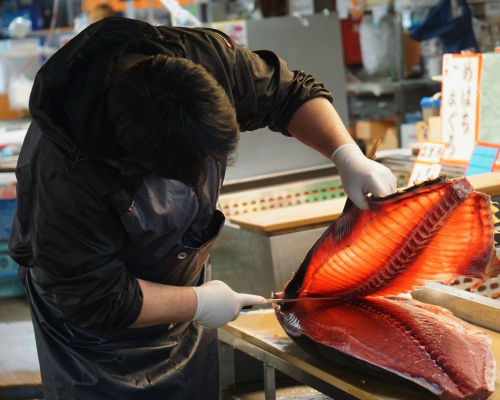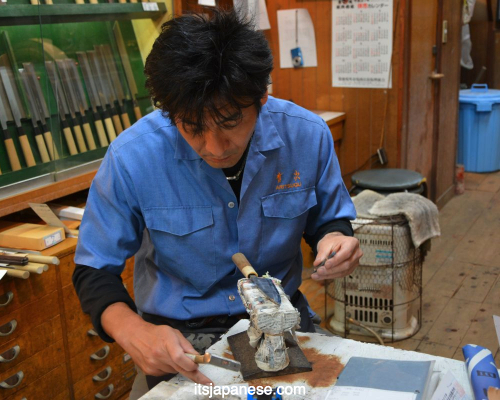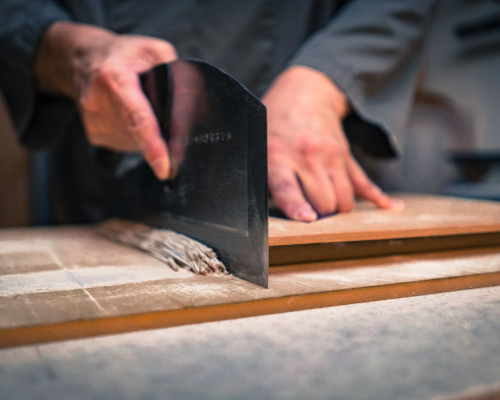Looking for the best Japanese knives?
Or just wondering… “What makes these knives any good?” Well, take a look at this guide. You’ll learn…
- Introduction to Japanese Knives
- What makes Them Special
- Types of Japanese Knives (and what they’re good for)
- Best Japanese Knife Brands
So, let’s jump in.

Introduction to Japanese Knives
Japanese cuisine is full of elaborate, well-presented dishes. Dishes with meats and vegetables that are cut so accurately that you’d expect some magic or possibly lasers are at play. But no, no magic or lasers. It’s the work of Japanese knives — extremely important tools for detail-oriented Japanese chefs.
In fact, Japanese knives are descendants of old samurai swords. Yes, knives are made from the same material as Japanese swords! This means that the steel usually contains higher amounts of carbon.

You’ll see these knives in sushi restaurants, as well as for serious home cooks. Although using these knives can take a bit more skill, they can be adapted for a variety of situations and cuisines.
Now, let’s look at what makes the special.
What Exactly Makes Japanese Knives so Special?
In other words, what makes Japanese knives better than knives from other countries?

1. Type of metal
Japanese knives are typically made with high carbon steel. Compared to normal stainless steel knives, these knives are sharper and easier to sharpen. Depending on the quality of the knife, it can be made from tamahagane, a traditional steel made from iron sand.
2. Handle
Compared to western knives, a big difference lies in the handle. Japanese knife handles use cured porous wood. Western knives are usually made with a synthetic or non-porous wood handle. Japanese knife handles have more grip and it is also lighter. The blade will contain more weight than the handle when cutting.
3. Bevel
The bevel refers to the way that the knife creates the sharp edge. With Japanese knives, the blade’s bevel can be different from a typical western knife.
Western knives are usually double-bevel, which means that both knife sides slant inward to form a point. Japanese knives can sometimes be single-bevel, and only one side of the knife is sharpened to make the point. Single-bevel knives can cut more precisely even though they take more skill. Due to western influence, Japanese people will use both single and double-bevel knives.
Recap:
- Sharper.
- Easier to sharpen.
- Wooden handles.
- Lighter.
- Blade weighs more.
- Single bevel.
- Cut more accurately.
Now that you know what makes these knives so special… let’s move on.
The 10+ Types of Japanese Knives

If you’re looking for the best Japanese knives, then it’d be good to know which kind you’re looking for. Yes, there are different types of Japanese knives — depending on what you’re cutting. So, let’s take a look. By the way, you can click on any of the images below (affiliate links) and check out the knives on Amazon.
1. Gyuto
Gyuto means “beef knife” and it can be used for both meats and vegetables. This is the closest one to a western chef’s knife. The blade is double-bevel, so it might be easier for those who are used to western knives.
- Used for meat and vegetables
2. Santoku
This knife is like the kitchen knife that many people have at home. It is double bevel and a bit smaller than the gyuto. You can use it for daily home cooking to cut a variety of ingredients.
- Used for common kitchen cutting needs.
3. Hankotsu
The hankotsu is used by butchers to cut hanging meat. This is not as common in restaurants and home kitchens.
- Used to cut hanging meat.
- Used by butchers.
4. Nakiri
The Nakiri Japanese knife is is a square edged blade that is used for vegetables. Because of the blade, you can put more arm pressure when cutting.
- Used for vegetables.
5. Yanagiba
With the yanagiba, it is possible to cut fish into sashimi with a variety of techniques. The blade is single-bevel and it can make precise cuts that fit with the type of fish. This is one of the most famous Japanese knife types because it is essential for making great sashimi.
- Used for sashimi.
6. Mukimono
This knife features a single-bevel angled tip that makes it possible to peel vegetables easily. It can be used to make decorative designs with vegetables.
- Used for vegetables.
7. Deba
What is the Japanese deba knife?
This is an extremely think, single-bevel knife. Why thick? Well, deba knives are used for cutting through tough fish. Especially for cutting off fish heads and bones.
- Used for cutting fish, fish-heads and bones.
8. Usuba
Meaning “thin blade”, this knife excels at cutting very thin pieces. They are able to execute a technique called sengiri, which is when a vegetable is cut into extremely thin sticks.
- Used for vegetables.
9. Honesuki
This is a special knife with an angled tip that is meant for removing the bones from chicken. It can maneuver and cut the tendons efficiently.
- Used for removing bones from chickens.
10. Kiritsuke
Kirituske requires the chef to have superior knife skills. The design of the knife is a combination of the yanagiba and usuba knife. It features a relatively long and thin blade.
- Used for removing bones from chickens.
11. Sobakiri
Japanese people use a unique knife called sobakiri to chop and make buckwheat noodles. These are one of the more traditional Japanese knife types. The sobakiri have a distinct square shape that almost looks like a saw.
- Used to make soba/buckwheat noodles.
Best Japanese Knife Brands To Get
If you’re in the marketing to get some well-crafted knives, then here are some good Japanese knife brands to know.
1. Tsukiji Aritsugu
This brand originally started with making swords in the 1560’s for samurai. They now produce knives and are made with the same materials and techniques. Although they are expensive, it is a top-notch knife for cutting raw fish.
2. Yoshihiro
Yoshihiro’s knife brand boasts handcrafted expertise. Each knife is carefully made by people who have over 50 years of knife making experience. The edge can be extremely sharp and made with high quality steel.
3. Hattori
Ichiro Hattori makes his knives by hand and he is considered one of the best knife craftsmen in Japan. He is passionate about producing the best knives without compromising on quality.
4. YuiSenri
These knives are made in Osaka, Japan and feature a high quality steel. They are each handcrafted and available in different lengths.
5. Syosaku
This Japanese knife brand is handcrafted with a beautiful finish. The blade has a hazy look due to the polishing technique. These knives are slightly more affordable than some of the other handcrafted knives.
6. Kanetsune
Combining both new and old techniques, Kanetsune knives are practical for daily use. They also have great craftsmanship and their company is located in Seki city, known for knives and cutlery.
7. Katsu knives
Although these knives are made in China, they use Japanese techniques and ensure a high quality knife. The prices are more affordable than Japanese-made knives.
Conclusion — Over to You
Now, you know a bit about the best Japanese knives, the brands, the types and what makes them special.
Which type is your favorite?
Which do you have at home?
Leave me a comment.
And of course, if I’ve missed something in this article, leave me a comment and I’ll add it in.
– Team IJ










